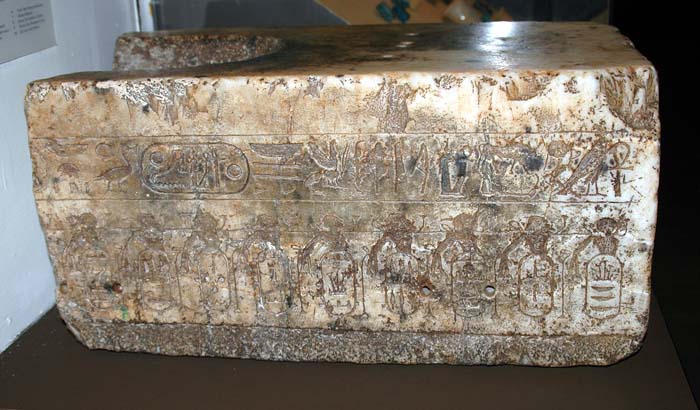
BASE FOR A ROYAL STATUE
Rameses II (Usermaatra Setepenra, ruled 1279-1213 bc) of the 19th Dynasty reigned for 66 years. He had many temples and monuments built during his reign and rows of seated or standing statues often line the approach to royal palaces and temples: A seated statue of King Rameses II was originally fitted into the depression at the top of this block of red granite.- The titles of the king are carved on the front and
the siege's of the base. On the front, the royal names in cartouches appear
twice to emphasise the duality of the Kingdoms of tipper and Lower Egypt.
The vulture of the goddess of tipper Egypt. Nekhbet, on the left, and the
cobra of the goddess of Lower Egypt. 'Wadjet, on the right present the sign
of life to the royal falcon representing the king.
- Originally the full royal titulary appeared on both
sides of the block, and reading from the front to the back may be translated
as:
- 'May he live, the Horus, Strong Bull, Beloved of
Truth, King of Upper and Lower Egypt, Lord of the Two Lands. Usermaatra
Setepenra, Son of the Sun, Lord of Diadems, Rameses, beloved of Amun'.
The traditional enemies of Egypt and the lands subject to the king are represented on the sides of the block, personified as bound and kneeling captives. They were therefore symbolically beneath the feet of the king and under his control. From the front of the block they are:
- 1. Hanuenbu (northernmost foreigners)
2. Shat (a Land in Nubia)
3. Tashema (Upper Egypt, the south land)
4. Sekhet-lamu (the people of the desert oases)
5. Ta-Mehu (Lower Egypt, the Delta)
6. Pedjet Shut (foreign barbarians)
7. Tehenu (Libyans)
8. Iuntyw Seti (natives of Nubia)
9. Mentiu Setet (Nomads of Asia)
10. Khet Hesy (Hittites)

-

Contact & Feedback : Egyptology and Archaeology through Images : Page last updated on 21-November-2025